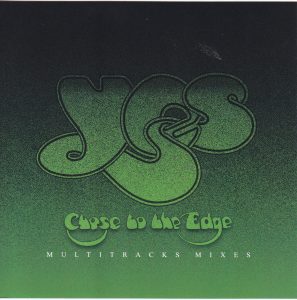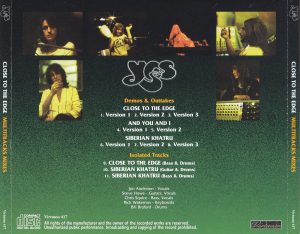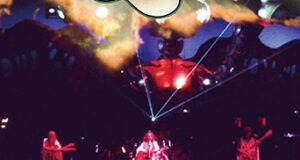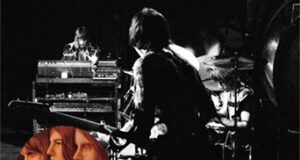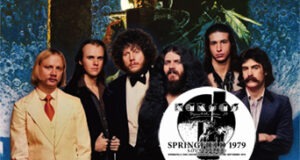YES / Close To The Edge Multitracks Mixes / 1CD / Virtuoso
Demos & Outtakes, Isolated Tracks STEREO SBD
Play sample :
Click Image To Enlarge
Beyond the band’s best masterpiece, the crisis is one of the treasures of one music genre “Progressive Rock”. A super-excellent demo album approaching the backstage of the production is a permanent preservation decision.
ア ー ト It’s an overly simplistic artwork with a masterpiece of three songs. A magnificent song like a symphony while maintaining the beat feeling as a rock band. What is evolving rock and what is a symphonic rock? There is no music work that embodies the ideal image as easy as “crisis”. Even now, nearly 50 years later, the brilliance has not faded even the fine dust, and it has become a huge entity that even the created YES parties can not surpass. I wrote that it was too much now, but what I want to say is that the studio that was producing the crisis was the site of a miracle. This work is a studio album where you can experience the process of assembling the miracle.
It is also fresh that surpasses the finished version. This depends on the take, but with some effects, but mostly less than the finished version. In particular, John Anderson’s vocals are more “live”, and you can feel the “closeness” of playing guitar and drums at your ears. [Highly complete demo that can be enjoyed as another version] ● Crisis (3 takes)
れ る What is drawn with such a sound is another figure of the super famous board “Kiyoshi”. From here, let’s talk about each song. First of all, there are three demos of the title track “Crisis”. The finished versions have different lengths, “Crisis # 1” is “3:21”, “Crisis # 2” is “13:27”, and “Crisis # 3” is “3:21”.
危機 “Crisis # 1” starts with “The Solid Time Of Change”, but from there it is a short arrangement that quickly enters the highlights. It’s like a single / total DL, but it’s not just short, it’s different for each take, vocals and melodies are different, and the performances that are layered precisely are different (partially). Completely imagined, it’s as if you were trying to create a medium-sized song from the intro and the most delicious parts.
「Alternative“ Crisis # 2 ”is a long version approaching the finished version (18 minutes 41 seconds), but the ensemble is rougher. The performance itself is not rough, but a type like a rough mix. Not only is the moog not overdubbed, but there are also very few choruses and effects. And the performance and vocal take are different. It’s not as simple as a skeleton, but it’s like taking a big song before decorating it.
The next “Crisis # 3” is again a short version of the 3 minutes range. It is a take that enhances the completeness of “Crisis # 1,” and the ensemble itself is quite close to the finished version. However, the sweetness of the claws is still visible due to the vocals. Eddie Orford is said to have assembled a large piece of music by cutting and pasting tapes, but it may be one of those parts.
● Comrade (2 take)
“Comrade” also includes two takes of different lengths, “Comrade # 1” is “10 minutes 57 seconds”, and “Comrade # 1” is “2 minutes 40 seconds”. First of all, “Comrade # 1” is the only take in this work that is longer than the completed version (9 minutes 59 seconds). Although you expect unexpectedly more grand tunes than the finished version, what flows out is the opposite world. Although the basic structure of the song does not change, the decorations such as chorus, effects, and overdub are clearly less, and the finish is fresh. There is no 4-minute or 9-minute steel guitar. The most surprising factor in the length is the ending. In the completed version, the theme replies, but in this take, the melody is completely different and the melody is greeted. Although it feels a little bit short, this is impressive. It is the largest treasure in this work that makes you feel another possibility of a masterpiece.
同 “Comrade # 2” is more complete with steel guitars in spite of its shorter length. Maybe they kneaded in each part.
● Siberian Cartour (3 takes)
The last “Siberian Cartour” also has a total of three takes, one long version and two short parts. “Siberian # 1” is “9 minutes 21 seconds”, “Siberian # 2” is “2 minutes 20 seconds”, and “Siberian # 3” is “2 minutes 6 seconds”. “Siberian # 1” is a fresh take that starts with a “1, 2, 3, 4” count. John’s scat “Duddu …” in the 3 minute range is also very different (you can hear the voice of the studio momentarily), and the 7 minute scat “Da!” Is not included. The cutting of the guitar in the rust part is a loud, and in the finished version the solo played by the harpsichord is also an organ. And more than that is the whole freshness. Although this paper mentions some minor differences, this work is not basically “locally different from the finished version”. Every part is different at the moment you listen. If the mix is rough, the rhythm squad and the raw are bare, the decoration is extremely small, as if it were a studio live for only five people. This work contains a vivid version of all three songs, but this take is the best in rawness.
“Siberian # 2” is a short version that is close to the finished version. It also has guitar solos and John’s scat, and has a lot of chorus and decoration. However, the effects are still rough, a version that seems to be packed with trial and error. The last “Siberian # 3” is at a similar stage, and may be the latter half of “Siberian # 2”.
The performance itself is the same as the finished version, but the freshness of extracting only two instruments is enormous, and the fine parts of the performance are super vivid, even to a little bend and tom turn. The outline of the song is also clear. Unlike the main part demo, it is not something that can be enjoyed as music, but the fun of the performance whose expression changes suddenly by transposition etc. far surpasses the finished version. Above all, it is a take that can not bear the fun that each part that created a miracle is exposed.
Above, it is a collection of 11 treasures, 76 minutes 43 seconds. Sound quality that I would rather call a studio album rather than a demo. And above all, it is a super-excellent studio soundboard recording that details the process by which miracles piled up to form a super-name board “crisis”. A historical one with a different dimension than many demo albums. Please enjoy it with a permanent preservation press CD.
1バンドの最高傑作という枠を超え、1つの音楽ジャンル“プログレッシヴ・ロック”の至宝でさえある超名盤『危機』。その製作裏舞台に迫れる超極上デモ・アルバムが永久保存決定です。
シンプルすぎるアートワークに、全3曲という大作主義。あくまでもロックバンドとしてのビート感を保持しながらもシンフォニーのような雄大壮麗な曲想。進化するロックとは、シンフォニック・ロックとは何物か。『危機』ほど分かりやすく理想像を体現した音楽作品はないでしょう。その輝きは50年近くが経とうとしている現在でも微塵も色あせることがなく、創り上げたYESの当事者達ですら超えることが出来ない巨大な存在となっています。思わず今さらすぎる事を書き連ねてしまいましたが、何が言いたいかというと「危機の製作していたスタジオは、奇跡が起きた現場」だったという事。本作は、その奇跡が組み上げられていった過程を体験できるスタジオ・アルバムなのです。
【デモの次元を超えたサウンド・クオリティ】
味気なく言ってしまえば、本作は『危機』のデモ・トラック集。製作途中の「危機」を3テイク、「同志」を2テイク、「シベリアン・カートゥル」を3テイク収録したもので、いずれも完成版とは大きく異なる(さらに3テイクのボーナス・トラックも追加収録されていますが、それは後述します)。言わば、名画のスケッチのようなものです。しかし、現実に流れ出る音楽はそんな言葉で表現しきれるものではない。まず「デモ」と言って思い出されるものとはサウンドが違いすぎる。一聴して完成版とはまったく異なっていながら、サウンド・クオリティ自体は完成版にまったく劣っていない。2010年代の初頭に突如として登場した音源なのですが、ダビング痕などまるでなく、下手をすると後から加工された公式リマスター盤よりも鮮度が良いくらい。「デモ=音がショボイ」という固定概念を木っ端微塵に叩き壊す超極上のサウンドボード音源なのです。
さらに完成版を凌駕しているのは生々しさ。これはテイクにもよりますが、エフェクトなどの加工も施されてはいるものの、ほとんどが完成版よりも少ない。特にジョン・アンダーソンのヴォーカルはより「生声」であり、ギターやドラムも耳元で鳴っているような「近さ」を感じられるのです。
【別バージョンとして楽しめる完成度の高いデモ】
●危機(3テイク)
そんなサウンドで描かれるのは、超名盤『危機』の別の姿。ここからは各曲について触れていきましょう。まず登場するのはタイトル・トラック「危機」のデモ3種。完成版はそれぞれ尺が異なり、「危機#1」は“3分21秒”、「危機#2」は“13分27秒”、「危機#3」も“3分21秒”です。
「危機#1」は「The Solid Time Of Change」からスタートしますが、そこから一気にハイライトへ入る短尺アレンジ。まるでシングル・得DL一途のようですが、単に短いのではなくテイク毎異なり、ヴォーカル・メロディも違えば、緻密に重ねられていく演奏も(部分的に)違う。完全に想像ですが、イントロと一番美味しいパートから普通サイズの曲を作ろうとしたかのようなテイクです。
代わっての「危機#2」は完成版(18分41秒)にも迫る長尺版ですが、アンサンブルはもっとラフ。演奏自体がラフなのではなく、ラフミックスのようなタイプ。モーグがオーバーダブされていないだけでなく、コーラスやエフェクトの類も大幅に少なく、演奏音が丸出し。そして、これまた演奏やヴォーカルのテイクが異なる。骨組みと呼ぶほどシンプルではないものの、飾り立てる前に大曲の構成を練っているようなテイクです。
続く「危機#3」は再び3分台の短尺バージョン。「危機#1」の完成度を高めたようなテイクで、アンサンブル自体はかなり完成版に近い。しかし、それでもヴォーカルの入りなどでまだツメの甘さが見える。エディ・オフォードはテープの切り貼りで大曲を組み上げていったとも言われていますが、そんなパーツの1つなのかも知れません。
●同志(2テイク)
「同志」も尺の異なる2テイクが収録されており、「同志#1」は“10分57秒”、「同志#1」は“2分40秒”です。まず「同志#1」ですが、これは本作で唯一、完成版(9分59秒)よりも長尺なテイク。思わず完成版よりも壮大な曲想を期待してしまいますが、流れ出るのは逆の世界。曲の基本構造は変わらないものの、コーラスやエフェクト、オーバーダブといった装飾は明らかに少なく、生々しい仕上がり。4分台や9分台のスティールギターもありません。また、長尺の要因にして一番の驚きはエンディング。完成版ではテーマがリプライズするのに対し、このテイクではまったく違うメロディで大団円を迎える。あとちょっとの詰めが足りない感じはするものの、これはこれで感動的。名曲の別の可能性を感じさせてくれる、本作でも最大級の秘宝です。
「同志#2」は、短尺ながらスティールギターも入って完成度が高まっている。もしかしたらパーツ毎に練り込んでいったのかも知れません。
●シベリアン・カートゥル(3テイク)
ラストの「シベリアン・カートゥル」もメインの長尺版1種とパーツ的な短尺版2種の計3テイク。「シベリアン#1」が“9分21秒”、「シベリアン#2」が“2分20秒”、「シベリアン#3」が“2分6秒”です。「シベリアン#1」は「1、2、3、4」のカウントから始まる生々しいテイク。3分台にあるジョンのスキャット「ドゥドゥドゥ……」も大きく異なっています(瞬間的にスタジオの話声?も聞こえます)し、7分台のスキャット「ダ!」も入っていない段階のもの。サビの部分のギターのカッティングがラウドですし、完成版ではハープシコードで弾かれるソロもオルガンです。そして、それ以上なのが全体の生々しさ。本稿では細かい違いについても触れていますが、本作は基本的に「完成版と局所的に異なる」というものではありません。どのパートも聴いた瞬間にまるで違っている。ミックスもラフでリズム隊も生が丸出しなら装飾も極めて少なく、まるで5人だけのスタジオライヴかのよう。本作には3曲とも生々しいバージョンが収録されていますが、生っぽさではこのテイクが一番です。
「シベリアン#2」は短尺ながらグッと完成版に近づいたバージョン。ギターソロもジョンのスキャットも入っていますし、コーラスや装飾もかなり施されています。ただ、エフェクト類はまだまだラフで、試行錯誤の詰めに入ったようなバージョンです。ラストの「シベリアン#3」もほぼ同じような段階で、「シベリアン#2」の後半部分かも知れません。
【完成版マルチから抜き出された個別テイク】
そんなデモだけでもお宝ですが、本作ではプレス化に際して更なる『危機』のスタジオ・サウンドボードを追加収録しました。それはアルバム3曲の抜き出しトラック。「危機」と「シベリアン・カートゥル」はリズム隊(ベースとドラム)で、「同志」はギターとドラムのトラックだけのものです。
演奏そのものは完成版と同じながら楽器2つだけを抜き出した生々しさは絶大で、ちょっとしたベンドやタム回しにいたるまで演奏の微細部が超ビビッド。曲の骨子も丸わかりです。本編デモと違って音楽として楽しめるものではありませんが、転調等でガラッと表情の変わる演奏の面白さは完成版を遙かに凌ぐ。何より、奇跡を生み出していったパーツの1つひとつが丸出しになる面白さが堪えられないテイクです。
以上、全11テイク・76分43秒の秘宝集です。デモと言うよりはスタジオ・アルバムと呼びたいサウンドクオリティ、音楽作品としても完成度。そして何より、奇跡が積み重なって超名盤『危機』を形づくっていった過程も詳らかにする超極上のスタジオ・サウンドボード録音です。幾多のデモ・アルバムとは次元の異なる歴史的な1枚。永久保存プレスCDで存分にお楽しみください。
(76:43)
DEMOS & OUTTAKES
Close To The Edge
1. Version 1
2. Version 2
3. Version 3
And You And I
4. Version 1
5. Version 2
Siberian Khatru
6. Version 1
7. Version 2
8. Version 3
ISOLATED TRACKS
9. Close To The Edge (Bass & Drums)
10. Siberian Khatru (Guitar & Drums)
11. Siberian Khatru (Bass & Drums)
Jon Anderson – Vocals
Steve Howe – Guitars, Vocals
Chris Squire – Bass, Vocals
Rick Wakeman – Keyboards
Bill Bruford – Drums
Virtuoso 417
 GiGinJapan Artwork of Japanese CDs (mostly)
GiGinJapan Artwork of Japanese CDs (mostly) 